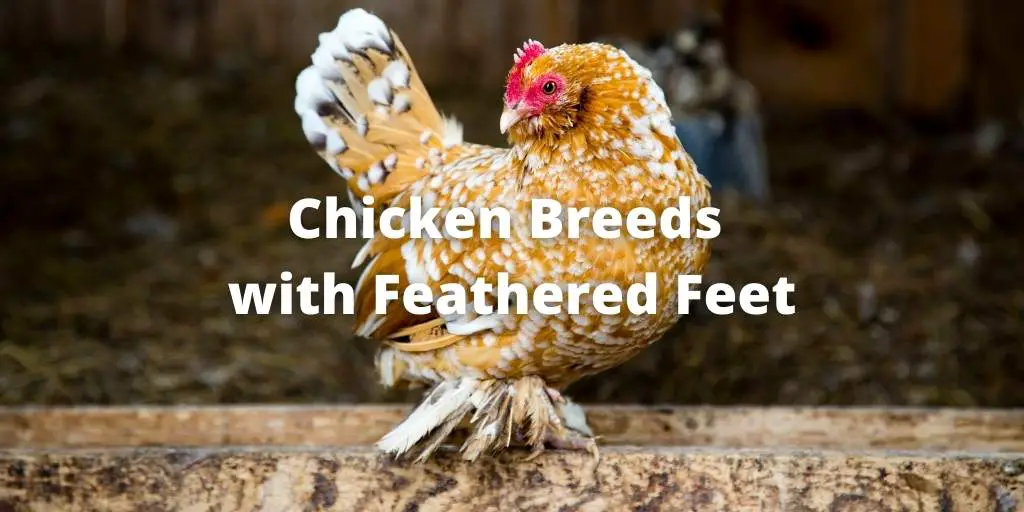
Chicken breeds with feathered feet have fluffy and fuzzy feathers on their legs. These hairy footed chickens have a lovely and unique appearance.
Feathered feet chickens found in both bantam and standard sizes. Few people say these hairy chicken feet looks ugly, but most of the chicken raised loves this appearance.
Chicken with feathers on feet are available in various breeds. Their fuzzy and furry feet give them a unique appearance, which is why people love them to raise as a pet chicken or for show purposes.
Below you will find a list of the top chicken breeds with feathered legs. These fuzzy-footed chickens give a wonderful look to your backyard coop.
So, What Kind of Chickens Have Fluffy, Hairy and Feathery Feet?
Best 11 Chicken Breeds with Feathered Feet (Characteristics, Egg Production, Size, and Pictures)
Here is the list of a few popular bantam and standard size chickens with feathered feet:
1. Croad Langshan
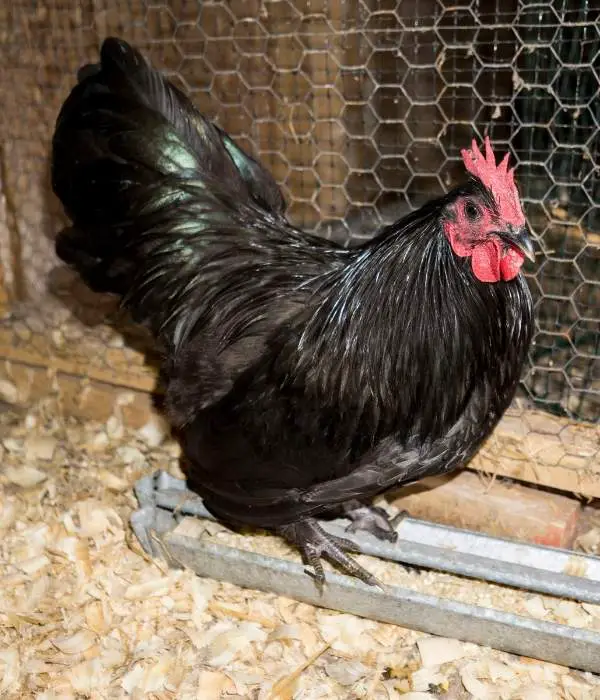
The Croad Langshan chicken breed originated in China. This is a large, black chicken breed with feathered feet.
The Croad Langshan are good layers of heavy brown eggs, and they lay about 150 eggs per year.
It is one of the best feathered feet chicken that is popular as a meat chicken because of their well muscular body.
A full-grown Langshan hen weighs around 8 pounds and 11 pounds for a rooster chicken.
Croad Langshan chicken breeds with feathered feet are hardy in winter, but have poor tolerance to heat and humidity conditions.
Young chicks may die due to cold weather during the first three months after hatching. You should take proper care of it during that brooding period.
2. Booted Bantam
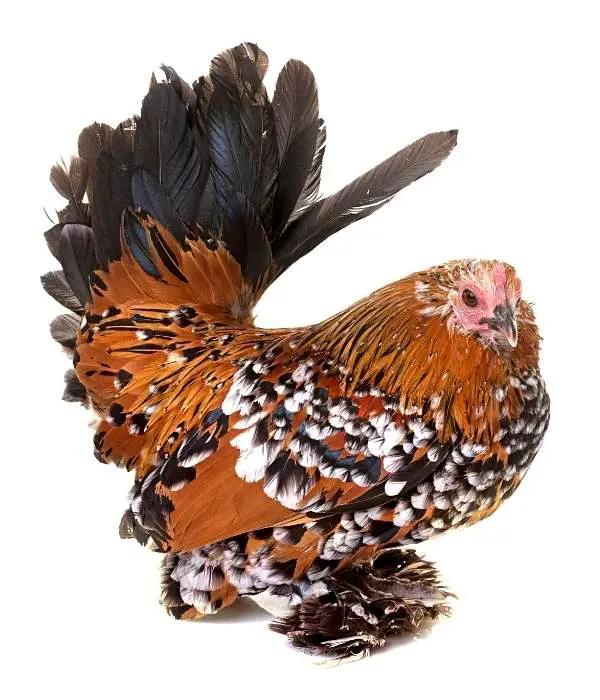
The Booted Bantam is a small chicken with feathered feet, but no feathers on the shanks or toes. They are good layers of tiny eggs with a tinted shell color. They lay about six eggs per week.
This bantam feather foot chicken has a fluffy and hairy appearance on the bottom part of legs. Booted Bantams are friendly chicken breeds that are easy to tame if appropriately handled as young chicks.
They can be very aggressive towards people and other chicken breeds during mating seasons or sometimes throughout the year after reaching the age of 2–3 years old.
The Booted Bantam chicken breed’s weight varies from 1.25 lbs for hens to 2 lbs. The Booted Bantam chicken has a lifespan of about 10 years.
3. Belgian d’Uccle
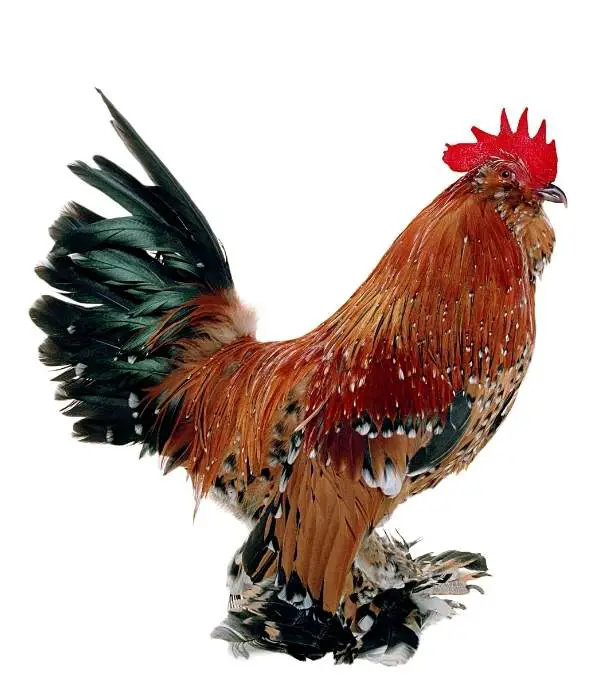
Belgian d’Uccles are the oldest chicken breeds with feathered feet in Belgium, dating back to 1835. Their legs have a very fluffy, hairy appearance.
They have a large chicken body structure with long legs with full feathers on them, which makes their legs appear short and fat despite their length.
The average weight of roosters is about 1.65 lbs, and hens are about 1.35 lbs. Just like other feathered foot chicken breeds, Belgian d’Uccles are excellent layers who lay brown eggs.
Each hen can produce about 90 eggs per year. They can live for a maximum of 8 years.
Belgian d’Uccle chicken breeds with feathered feet are not broody chickens. They tend to fuss a lot and jump onto their chicken coop’s roof if someone or something has upset them.
4. French Marans
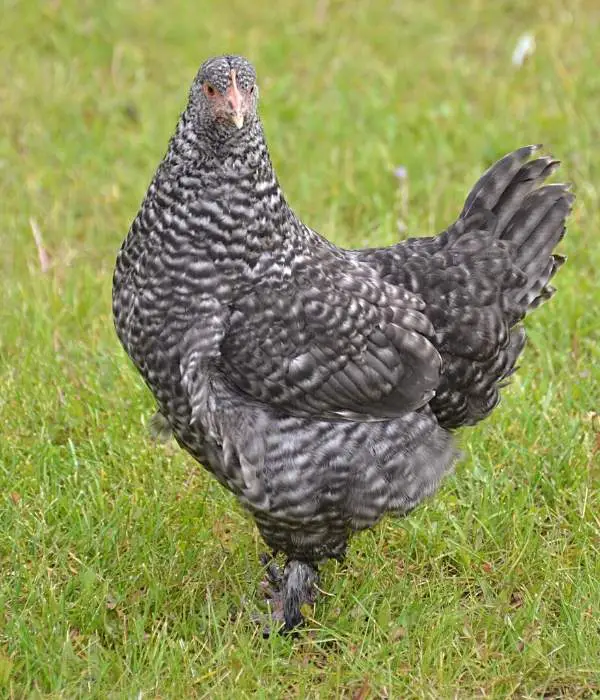
The French Marans is also a large size hairy feathered feet chicken in the list. They are available in black, red, golden, silver, and white color.
You may see different feather patterns throughout its body, which makes it one of the most beautiful chicken breeds.
The chicken is good for its looks and has other great qualities that make it an excellent choice for meat production.
They have a large and robust chicken body structure despite being a bantam chicken. The feathers on the feet are not much fluffy in hens, but in roosters you can see more dense hair like appearance.
French Marans have serious attitude problems, so you should keep them away from other chicken breeds in a separate chicken pen.
They may attack and kill the chickens of different breeds that come near their coop. Marans lay small to medium-sized brown eggs, which are more nutritious than the chicken’s white egg, and they tend to be poor layers during winter.
The chicken is very friendly and easy to tame if appropriately handled when they are baby chicks. It’s not recommended for someone who doesn’t know how to handle chicken well.
Their lifespan is around 7–8 years, depending upon the treatment provided by the owner, as healthy chickens with good care live longer than those living in miserable conditions.
A French Marans chicken standard rooster weighs about 7.5 lbs and hens 4.25 lbs. For a bantam male fowl, the weight is about 2.25 lbs. and 1.75 lbs for a female bantam.
5. Brahma Chicken
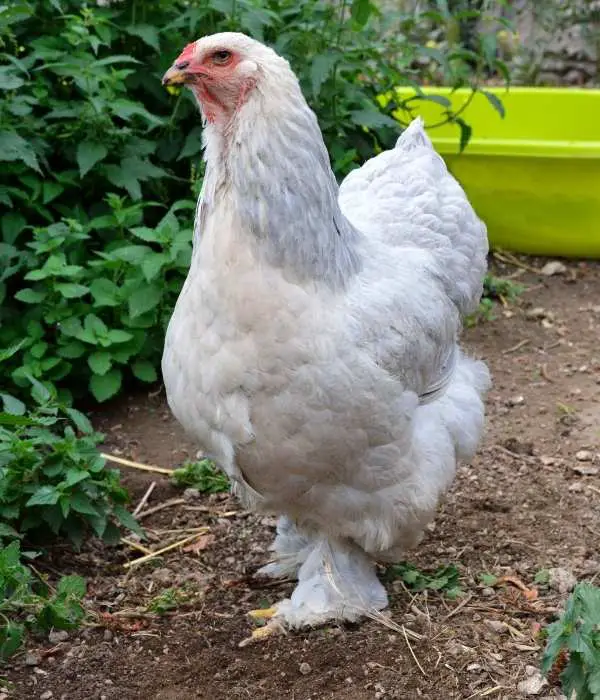
Brahma chicken breed is the heaviest chicken globally and one of the large chicken breeds with feathered feet, weighing between 10-12 lbs when fully grown.
They have full-body feather coverage, including their upper legs. The tips of the lower legs are not that fluffy, so they are less vulnerable to cold weather than other chicken breeds with feathered feet.
Still, the feathered feet of this chicken looks like wearing a shoe. Their vast body structure makes it difficult to escape from predators or walk around in a portable chicken coop.
They have a friendly personality that makes them easy to tame if appropriately handled as young chicks.
It’s recommended not to keep them together with other chicken breeds unless you have a chicken farm with chicken pens five times larger than standard chicken coops.
Brahma chicken breed lays eggs that weigh more compared to other chicken breeds.
Even though they lay jumbo eggs, their production rate is only around 150–200 eggs per year on average, and some hens stop laying eggs entirely at the very young age of one year.
Their lifespan is between 5–8 years, depending upon the treatment provided by the owner.
6. Cochin
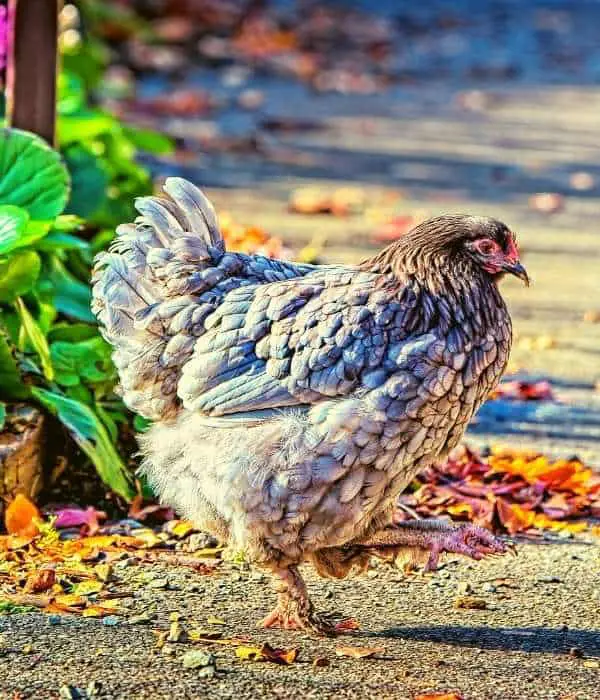
Cochin chickens are feathered-footed, easy-to-raise chicken breeds. Their upper and lower legs have low, fluffy feathers.
If appropriately handled when young, chicks of around one month old. They tend to get sick quite often. Such types of chicken breeds that frequently get sick because of the possibility of spreading diseases.
You should not keep the breed together with other chicken breeds unless you have a chicken farm or a large chicken coop.
Cochin’s don’t show any warning signs before falling ill. They might even die within a few hours after showing symptoms of sickness, especially coccidiosis, which is one of the most common chicken diseases and mainly occurs in chicken breeds with feathered feet.
They lay large-sized chicken eggs. Their production rate is only around 100–150 eggs per year on average, and some hens stop laying eggs entirely at a very young age.
Their lifespan is between 8–10 years. The bantam fowl weighs about 26 to 30 ounces, and the large chicken weighs about 8.5-11 lbs.
7. Faverolle
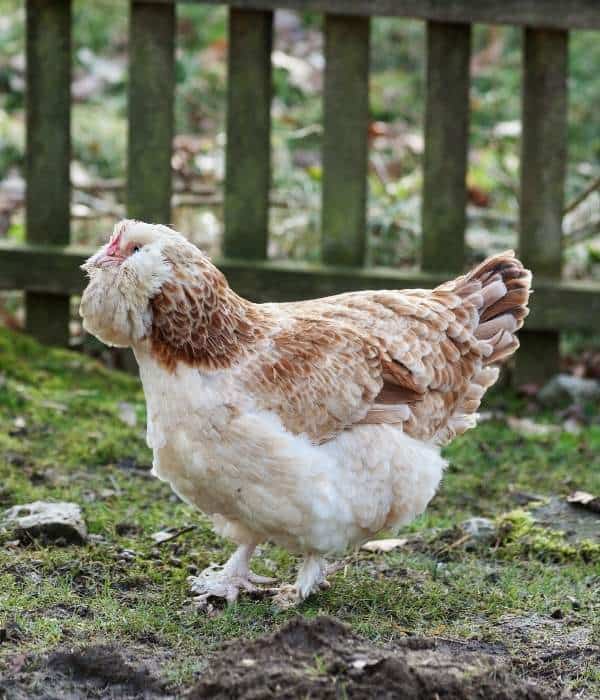
You should handle chicken breeds with feathered feet carefully, as they are not as hardy as chicken breeds with no feathers. Their chicken feather coverage can’t protect them from the cold weather.
The Faverolle chicken breed produces around 200-250 chicken eggs per year on average. Their chicken eggshell color is either pure white or tinted a creamy yellow, depending upon the types of chicken species.
The weight of a large chicken is between 6 lbs and 8.5 lbs. Their lifespan is around 4–8 years, depending upon the care provided by their owners.
8. Silkie chicken

The Silkie chicken breed has unique physical characteristics that make it visually different from other chicken breeds, including a black and white coat color pattern that gives an appearance of fur rather than chicken feathers.
The Silkie chicken breed has feather coverage only on the bottom part of their chicken feet. They are pretty different from chicken breeds, with complete chicken foot feathering.
Silkie chickens require more care and protection against cold weather and predators. Because of their weak legs and fluffy hairy feathers, they can’t support large body structures or survive winters.
They have long feathers covering most parts of their legs to protect them from freezing in winter.
The chicken breed produces around 150–200 chicken eggs per year on average, and their eggshells are either white or tinted a creamy yellow, depending upon the types of chicken species.
Their lifespan is between 8–9 years, which makes them one of the longest life chicken breeds. The bantam Silkie’s weighs about 32–36 ounces and standard size 3-4 lbs.
9. Pekin Chicken

The Pekin chicken breed is also called the Long Island chicken breed. They are feathered foot chicken breeds with fluffy fully covered legs.
It originates in China, where chicken breeds were selectively bred for their chicken meat production potential over many years.
Even though they are not suitable for chicken egg production, they are outstanding chicken meat producers compared to other chicken breeds because of their large size.
Pekin chicken weight ranges between 20 ounces for female fowl and 25 ounces for male fowl.
Their lifespan is around 6–8 years, depending upon the care provided by their owners. Pekin chickens are one of the best bantam feather foot chickens.
10. Sultan Chickens
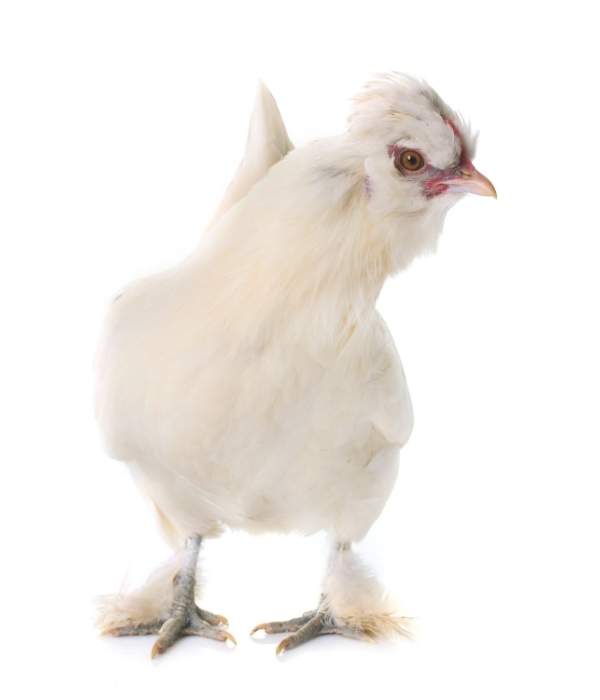
The Sultan chicken breed is a trendy chicken breed among chicken hobbyists and backyard chicken farmers around the world. The Sultan chickens have thin legs with soft fluffy feathers on their lower legs.
They are large chicken breeds with rich feather coverage that protects them from freezing weather or hot temperatures and predators.
They produce around 200 chicken eggs per year on average, which is less than other chicken breeds with feathered feet. Their eggshells are white or tinted a creamy yellow, depending upon the types of chicken species.
The bantam fowl weighs about 25–30 ounces and 4-5.8 lbs for large chickens. Their lifespan is between 4–6 years, but they tend to show premature aging after six years.
11. Malaysian Serama Chicken Breed
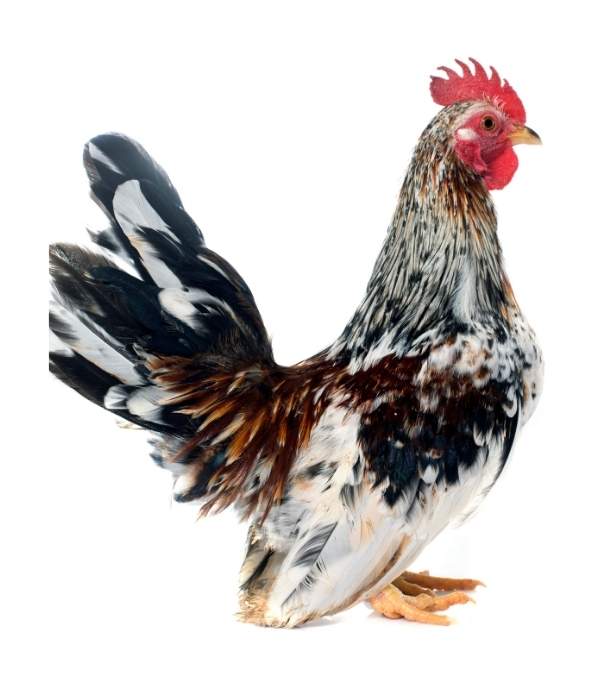
The Malaysian Serama chicken breed is not as good as chicken meat breeds, but they produce more chicken eggs per year on average.
Their eggshell color is either pure white or tinted a creamy yellow, depending upon the types of chicken species.
They can be considered one of the best chicken breeds with feathered feet because they have all the chicken feathers covering the bottom of their chicken legs.
Even though they don’t have leg protection against cold during winter days, they are still excellent chicken breeds to consider raising in your backyard to enjoy both eggs throughout their lifetime.
The lifespan of these feathered leg bantams is around 7–8 years, depending upon the care provided by their owners.
They produce about 180–200 chicken eggs per year on average. The chicken weighs between 1.1 lbs and 2.4 lbs.
Reasons Behind Chickens Have Feathered Feet
Here are some common reasons behind the feathered feet in chickens:
1. Cold climate
Feathered foot chicken breeds like Cochins were developed in China and Turkey (both countries having a cold climate).
So, breeds were developed with fully feathered feet to survive better in the freezing temperatures because of their excellent hair coats, providing extra protection from rain and snow melting.
2. Predators
Chickens with feathers on their feet are being reared now throughout the world due to their unique appearance. They have fully feathered legs, hardness, a large body size, and a pea comb on top of the breed’s head.
This makes it difficult for predators to catch species by their comb. Large body sizes can fight predators by having a formidable beak.
3. Heat Production
In origin, the breed was developed in China and Turkey (both countries have a cold climate), so breeds were developed with fully feathered feet to produce more body heat by trapping the heat produced by their legs.
4. Better insulation
Feathers on the chicken’s legs help trap air bubbles next to the chicken’s skin like an insulation material.
So, it helps them better during the winter months, when there is a lower amount of exposed skin for the production of body heat by chickens.
Problems With Feathered Feet in Chickens
A few major problems with feathered feet are:
1. Cleaning
It is challenging and time-consuming to clean chickens’ leg feathers because the length of chickens’ feathers can reach up to half a foot, making it difficult for them to walk.
They are very soft and hairy so cleaning them with water make them wet which takes times to dry. It may cause problems like bumblefoot.
2. Sickness problem
It takes time for the chickens’ fully feathered feet to dry off until the next rainstorm comes along.
Water gathers in between feathers, making it easy for bacteria, fungi, or parasites (mites, lice) to grow in wet areas, so chickens become more susceptible to sickness.
Read our complete guide on chicken dewormers.
How to Deal with Feathers on Chicken Feet?
Below, you will read a few tips to deal with feathers on chicken feet:
- Clip all the feathers around the chickens’ back and neck areas for easy access while cleaning or removing mites and parasites.
- Keep them clean by removing grass, leaves, and other debris caught in between feathers, which can lead to skin injuries because it is difficult for birds to move during spring when mud becomes deep due to recent thaws.
- Provide some soft material for chickens to step on after their release from the coop, where the flooring should be made of rubber or other materials that don’t cause injuries to the chickens’ feet while walking.
- Although breeds with fully feathered legs get dirty more often, it is recommended to maintain a high level of hygiene by washing this breed’s legs and toes sporadically, which is always better for preventing diseases.
Bottom Line
Leg problems are more common in chicken breeds with feathered legs than in those without feathering.
Chicken owners must regularly trim the chicken feathers around the chicken feet to keep them healthy.
If you don’t want your chickens’ legs to get hurt by sharp rocks, thorns, trees, and other objects in their surroundings, then trim their feathers regularly.
Also, the remarkable thing about chicken breeds with feathered feet is that they can stay cool during summer days when you have hot weather conditions.


Thank you thank you so much much good information the bantams have always been my favorite